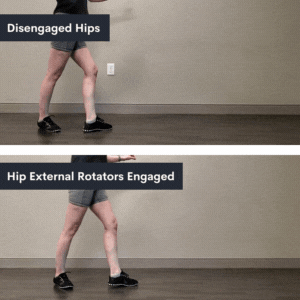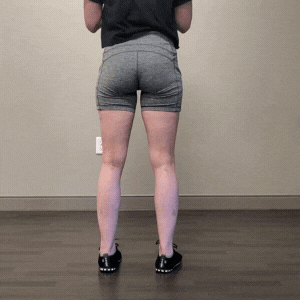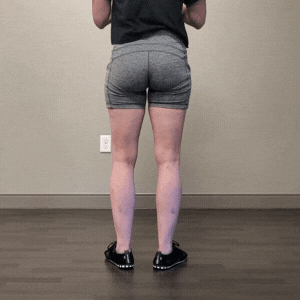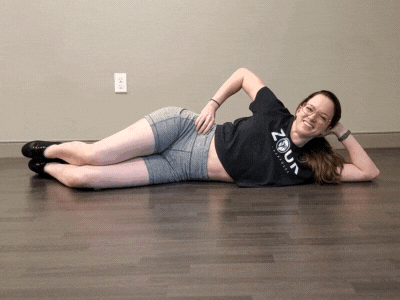How to “Engage Your Hips” In Zouk (Pt 1): Turn Out
Note: This is Part 1 of a 2-part series on hip engagement in zouk dancing:
Part 1: How to “Engage Your Hips” In Zouk (Pt 1): Turn Out (this post!)
Part 2: How to “Engage Your Hips” In Zouk (Pt 2): Keeping Level Hips
As a flexibility coach who works with students on hip range of motion on a daily basis, I’ve learned a thing or two about the hips! It’s been super fun taking my knowledge of hip biomechanics (from flexibility training) and learning how to apply it to zouk dancing.
Honestly the phrase “engage your hips” is a pet peeve of mine because it is so damn general. But it’s probably something we’ve heard in class at one point or another! For context, there are more than 15 muscles in the hips, and our hips can move in several ranges of motion - so “engage the hips” could mean literally anything.
Typically, in Brazilian zouk, when we talk about “hip engagement,” we’re often referring to a couple of different groups of muscles or ranges of motion:
Hip external rotators (aka the “turn out” muscles)
Hip adductors (aka inner thigh muscles)
Hip abductors (aka outer hip muscles)
There’s a lot to cover here, so we’ll be breaking this topic into 2 posts to dive into these muscle groups to:
Better understand how they can help us in zouk (spoiler alert: they’re a huge help with stability and balance!)
Find these muscles in your own body
Learn drills to strengthen these muscles, and
Practice using this engagement in your dancing!
Today’s post will specifically focus on engaging our “turn out” muscles.
A note before we dive in:
While this hip engagement can be helpful for all zouk dancers, it is admittedly more important for followers due to the frequency that followers spin.
Leaders, consider this a “nice to have.”
Followers, consider this a “need to have.”
What Is “Turn Out” & Why Do We Use it in Zouk?
Hips externally rotated (thighs “turned out”)
Neutral hips (no thigh rotation)
Hips internally rotated (thighs “turned in”)
When we talk about “turn out,” we’re specifically referring to the action (engagement!) of using our hip muscles to externally rotate (rotate to the outside) our thigh bones. We want these muscles firing/engaging virtually all the time when we dance for a couple of reasons:
Turning our legs (and feet) out to the side widens our base for balance, allowing for more side-to-side balance than if our toes were pointing straight forwards
Keeping our external rotators engaged helps stabilize the hips, making them less wiggly and noodle-y when moving (which also helps with balance)
The deep rotators also help keep the ball-and-socket hip joint snug and supported without only relying on our ligaments and connective tissue to support all of our body weight (ouch!). Habitually relying on your connective tissue to support your joints can lead to weaker joints, end result in injury
Maintaining the turnout through the hip prevents internally rotating the thigh, accidentally caving the knees inwards and preventing tweaking our knees or ankles into an injury (also ouch…). Let’s take a look at what that could look like in a (follower’s) lateral step:
Take a look at the follower’s right leg (the leg they’re turning towards) as they pivot in this lateral
Here’s a screenshot of the turn: notice how the knee stays caved in towards the midline in the “disengaged” hips variation even as the hips are twisting to the right
Some would also argue that using leg turnout is a preferred aesthetic choice because it lengthens the visual “lines” of the legs (especially when combined with a toe pointe).
It’s important to think of turn out as an active engagement (a muscle contraction), and not just being able passively sploot our legs open into a crazy ballerina position. Just because you might have a pretty large range of motion of hip external rotation (perhaps you’ve trained your “turn out” previously in dance), unless you are actively engaging your hip rotators & stabilizers when dancing, your hips will remain noodle-y (even if your thighs are rotated in the “right” direction), which will make dancing with stability and responsiveness a challenge!
That means more “turn out” range of motion is NOT necessarily better (or even necessary) for zouk. How far you can rotate the thighs isn’t nearly as important as being able to turn on the muscles responsible for thigh rotation (even if the rotation is super small) and to keep them engaged under stress (ex. When we are turning and our thighs naturally want to turn in).
OK, so now we understand that we want to engage these magical muscles, but what muscles are we talking about here?
The Turn Out Muscles: Obteruator Inter-What?
There are a whole slew of muscles in our hip that - when engaged - help us turn out our thigh (aka externally rotate the thigh/hip).
The most important are the deep hip rotators, a group of 6 muscles in the back of the hip (underneath the glutes) that sound suspiciously like spells out of Harry Potter:
This is the back/butt-side view of the deep hip rotators that sit underneath the glutes.
Image credit: Beth ohara (raster), Offnfopt (vector), CC BY-SA 3.0, Wikimedia Commons
Deep Hip External Rotators:
piriformis
gemellus superior
gemellus inferior
obturator internus
obturator externus
quadratus femoris
All of these muscles connect the hip bone to the thigh bone, and when contracted, help rotate the thigh bone to the outside and stabilize the hip. Depending on the position of the leg (ex. standing upright vs. lifting one leg in front of the torso), some of the hip rotators do more of the work than the others (which is beyond the scope of what we need to worry about for this post). Since we’re talking about using turnout in zouk dancing, we’ll be focusing on finding our turnout muscles in a standing (hips extended as opposed to hips flexed) position.
The larger, more superficial (“closer to the skin”) glute muscles, like the gluteus maximus and parts of the gluteus medius also assist in turnout. Generally we don’t want to only use our glutes for turnout because they are responsible for other things too (like extending our leg back behind us when we step backwards). So it’s important to learn how to engage those littler, deeper rotator/stabilizer muscles to maintain our turnout when dancing so the glutes don’t have to be working overtime!
How to Find Your Turn out Muscles
My absolute favorite way to introduce new students to their hip external rotators comes from a Bruno Galhardo workshop:
Start standing comfortably with feet hip-width apart
Place your hands on your butt
Rotate your thighs to the outside and “feel your butt talking to you” (you can also think about clicking your heels together a la Dorothy in the Wizard of Oz)
Those are your hip external rotators! In this exercise, you are concentrically contracting the hip rotators (meaning you’re contracting them while the muscle length is shortening).
Now for a real challenge, try that same exercise, but don’t actually move your feet - this is a great way to practice engaging the muscles even without affecting any movement (this would be an isometric contraction, a contraction without motion):
Conditioning Drill: Clamshells
Strengthening Turn out Engagement
Clamshells are for more than just jazzercise - they’re a great way to strengthen your large and small hip external rotators.
Start lying on your side with your feet stacked on top of one another. Bend your knees to scoot your feet a little closer to your butt (try not to scoot them super far in, the closer you bring your feet towards your butt, the more you flex your hip, and we don’t need to train our turnout in a deeper hip flex than what we use dancing)
Keeping your hip bones pointing forwards (don’t let the hips tilt or twist backwards), and keeping your toes touching, lift the top knee - this should feel like a squeeze in the side of the butt as the front of your thigh rotates to the outside and the knee lifts
Slowly lower back down
Repeat for 8-15 reps on one side, then switch sides
Now Try It Dancing!
Now try to engage these muscles next time you’re dancing. Give it a try solo, or with a partner. How does it feel trying to do your basic walk? A bit more balanced? Perhaps a bit wonky due to having to focus on something you never normally think about? Both are OK!
If you really want a challenge, try filming yourself and play “freeze dance” when watching the video:
Turnout Engagement Drill: “Freeze Dance” a Zouk Video
Set up a camera to be able to record your dancing (bonus points if you try this solo without a partner!) - make sure you can see your hips and your feet
Record just 20-30 seconds of doing basic dancing (basic step, lateral, simple turns, etc)
Pull up the video and stop it randomly throughout, freezing the frame, to check: what direction are my thighs facing? If your external rotators are properly engaged, your thighs and your feet should be slightly turned out to the sides. If one (or both) feet are pointing inwards, then you know you’ve lost your engagement. Pay special attention to moments when you are pivoting and turning, those are the most challenging!
Don’t be disheartened if you spot lots of moments in your dance when you accidentally lose your turnout engagement - learning to activate these muscles, especially when turning, is a challenge! I personally still struggle with keeping them engaged during boomerang/bonus footwork because that’s a challenging traveling turn pattern (in my opinion).
But if you keep working at it, I promise you’ll get better!
And stay tuned for later this week for Part 2 when we talk about another complementary aspect of hip engagement: learning to engage our outer hips to smooth out our movements… (read that post here).











